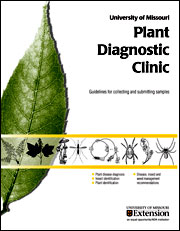Collecting plant disease samples
- Collect recently affected plant tissue representing all stages and aspects of the problem.
- Healthy or dead plant material is not sufficient for diagnosis but can be useful for comparison.
- When possible, take samples before applying fungicides or other agrochemicals. These chemicals make it more difficult to identify plant pathogens.
- Submit entire plants with roots intact (dug, not pulled) if possible. Wrap the root ball so that it does not dry out. If the plant is too large to send, submit a handful of root material packaged in a separate plastic bag with moist (not wet) soil.
- Shake excess soil from the roots if you wish, but do not wash soil from the sample.
- Take photographs (digital images) of both healthy and sick plants, including close-ups of symptoms
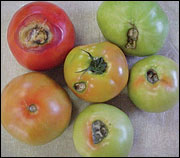 Fruits or mushrooms
Fruits or mushrooms
Select fruits with early symptoms of disease, not those in advanced stages of rot. Wipe away excess moisture, and wrap individually in a dry paper towel. Do not place in a plastic bag. Place samples in a crushproof container with packing material to prevent movement. Ship perishable items for next- or two-day delivery.
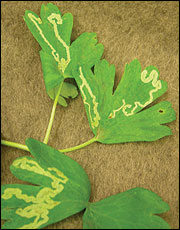 Leaf spots
Leaf spots
Collect 10 to 20 leaves showing all stages of the symptoms. Highly succulent leaves should be treated like other fleshy tissue samples. Place leaves between cardboard or heavy paper, or submit leaves still attached to a branch.
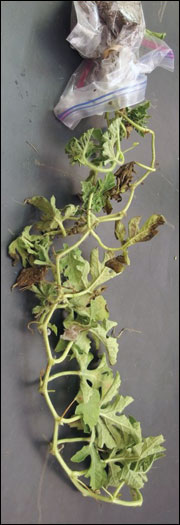 Yellowing and general decline
Yellowing and general decline
Submit entire plant if possible. Wrap roots, including soil, in a plastic bag, but leave the top of the plant exposed.
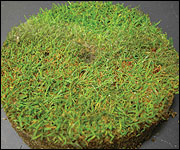 Turfgrass
Turfgrass
Dig up two plugs at the margin between healthy and affected turf. Plugs should contain two-thirds symptomatic and one-third healthy turf. Each plug should be 4 inches by 4 inches and should include 4 to 6 inches of soil. Wrap plugs individually in aluminum foil to enclose the soil, but leave the foliage uncovered.
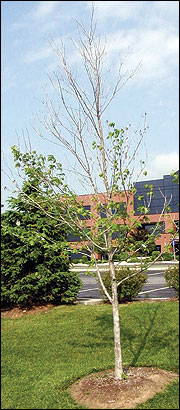 Tree wilt
Tree wilt
Collect samples from symptomatic branches. Do not collect from dead branches. Branch sections should be ½ to 1 inch in diameter and about 6 inches long. Place branch samples in a plastic bag to retain moisture. Also submit leaves from the branch, pressed between cardboard or heavy paper.
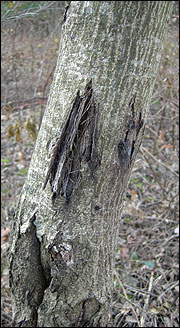 Stem lesions, diebacks, cankers and galls
Stem lesions, diebacks, cankers and galls
Select branches with active lesions or young galls. Cut branches or areas that include healthy as well as affected tissue. Dead branches and healthy, unaffected branches are usually not suitable for diagnosis. Call if the canker is on the trunk or a branch too large for shipping.
Collecting plant and weed ID samples
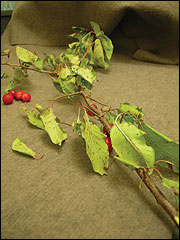 Woody plants (trees, shrubs, woody vines)
Woody plants (trees, shrubs, woody vines)
- Leafy branches must include the terminal end with at least five leaves or buds. When possible, include flowers, fruit, thorns, seeds or any other plant parts present.
- Submit an entire branch and other plant parts when available.
Herbaceous plants (plants with green or soft-tissue stems that die back each year) or grasses
- When possible, the entire plant should be dug, not pulled, from the soil so that a representative portion of the roots remains intact to a depth of 4 to 5 inches. If rhizomes, bulbs or tubers are present, include these with the basal portion of the plant. If the plant is flowering or fruiting (seeding), send a portion of this part of the plant.
Collecting insect or arachnid samples
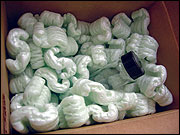
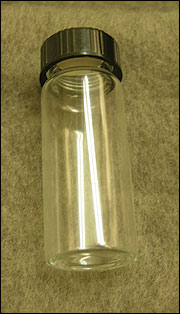
- Tiny nonflying insects on plant material may be submitted in a sealed plastic container.
- Submit larger insects inside an insect vial, right, or leakproof container filled with alcohol. If alcohol is unavailable, freeze the sample for 24 hours prior to shipping
- Do not freeze soft-bodied insects.
- Insect pests of animals or humans will be accepted only in vials filled with alcohol.
- Send samples in a crushproof container with ample packing material, far right.
- See submission form for more details.
Packaging plant samples
- Enclose roots and soil in a plastic bag. Bundle multiple specimens together and then wrap the bundle in newspaper. Never include sources of moisture such as wet paper towels. Excessive moisture may cause plant decay or fungal growth during shipment, making diagnosis difficult.
- Package wrapped samples in a crushproof box with packing material to prevent movement during shipment.
- Ship the package so that it will be received no later than Friday morning. Delivery to the clinic is unavailable on weekends and holidays.
- Consider overnight delivery for highly perishable samples.
- If samples cannot be shipped immediately, keep them refrigerated.
- Samples may be delivered in person to the clinic between 9 a.m. and 4 p.m. Monday through Friday, excluding University holidays.
- All samples must be accompanied by a fully completed sample submission form (see page 4).
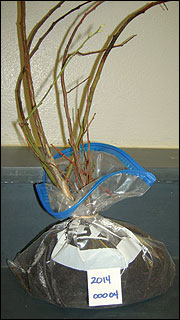 Packaging regular samples
Packaging regular samples
Pack plant problem samples in sturdy boxes with enough packing material to prevent excessive movement. Damage during shipment can change a good sample to a poor one. Do not ship samples in an envelope.
Delays in mailing can cause deterioration of plant samples. Mail samples early in the week to avoid delaying delivery over a weekend. For highly perishable items, always consider overnight delivery.
Regular sample packaging, right. Enclose roots and soil in a plastic bag before shipping.
Packaging regulated pest samples
Suspected pests of regulatory concern, such as thousand canker disease or soybean rust, require special handling and packaging to prevent the spread of pathogens. Place a sample inside a sealed plastic bag with a dry paper towel. Then seal the first plastic bag inside a second sealable bag.
 Place the double-bagged sample inside a sturdy box, and add packing material to reduce movement. Seal all seams of the box with packaging tape. Samples should be hand-delivered or sent by overnight delivery to the clinic. As a last step, notify the clinic that a package of regulatory concern has been shipped.
Place the double-bagged sample inside a sturdy box, and add packing material to reduce movement. Seal all seams of the box with packaging tape. Samples should be hand-delivered or sent by overnight delivery to the clinic. As a last step, notify the clinic that a package of regulatory concern has been shipped.
Regulated pest packaging, right. Double-bag samples of regulated pests.
Diagnosis and reporting
Diagnosis of plant damage requires examination and testing to detect disease-causing pathogens on plant material. The clinic also checks for insect pests and assesses damage that may have been caused by nonliving agents.
Weeds and insects are identified based on physical characteristics. When plant problems are caused by cultural or environmental conditions, determining the exact cause may not be possible. However, when enough information is included, the clinic can suggest possible causes for the damage identified in the diagnosis.
After a diagnosis is made, reports are returned by email or mail.
The Plant Diagnostic Clinic cannot do the following
- Determine pesticide residue
- Identify human or animal pathogens (disease-causing organisms)
- Identify disease, plant or insect from poor-quality samples
- Identify species of most pathogens; identification is limited to genus only
- Positively identify certain viruses
Fees
Initial
- $10 Digital photos
- $15 Plant disease (including residential turf)
- Microscopic observation
- Incubation in a moist chamber if needed
- $15 Plant/weed identification and control measures
- $15 Insect identification and control measures
Supplemental
- $20 Serological testing
- ELISA or immunostrip
- $20 Bacterial or fungal isolation
- Pathogen identification using standard isolation techniques
- Limited PCR-based diagnostic services
Fees subject to change.
Forms
The Plant Diagnostic Clinic submission forms are designed to provide the information necessary for the clinic to provide a complete, accurate and timely diagnosis or identification of samples and to provide appropriate control recommendations. Submission forms are available at your local county extension center or online at Plant Diagnostic Clinic.
Samples may be submitted directly to the clinic or through county extension centers. On the web, see locations for the center nearest to you.
The clinic must receive a physical sample or photographs and a completed diagnostic submission form before an accurate diagnosis can be made and treatment recommendations given.
